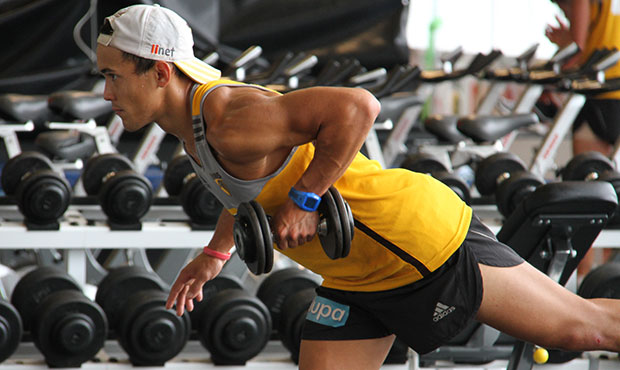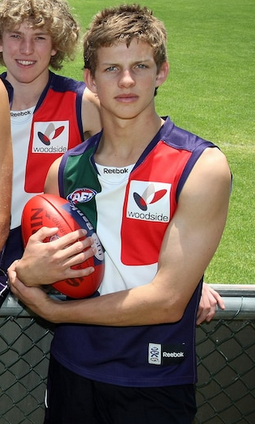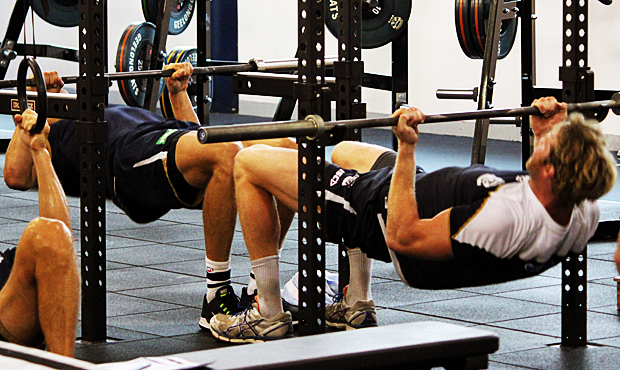Strength Training and Young Players
At what age should young players begin strength training? And how young is too young? Is strength training safe for 14, 15 and 16 year olds?
The simple answer to these questions is a resounding ‘YES’.
There is however a ‘BUT.’
And this but is ‘but that is provided that the strength training that is being performed is appropriate for the individual doing it.’
A program of fairly heavy lifting that a 24 year old who has been doing weights for 7 or 8 years, certainly isn’t safe or appropriate, and certainly not necessary, for a 15 year old who is just starting out with strength training. This discussion ties in heavily with another discussion that we had on individualising training. This is one example of individualisation.
Generally the youngest that guys start to get interested in doing weights for footy is around 14 or 15 years old (girls generally take a while longer to convince due to unfounded beliefs that weight training will make them big). And this is perfectly fine, provided that the training that they are doing is appropriate, and is focused on what is really important. By this, I mean that at 14 or 15 years of age, the aim of strength training is about laying a foundation of functional movement and correct technique, as well as getting muscled and joints slowly adapted to this form of training. In other words, at this age, strength training is more about building for the future years ahead, as well as of course experiencing some increase in strength and muscle in the process. However, it is NOT about lifting maximally and putting on as much muscle as possible in the next 6 months to bulk up for the under 16 season. Many young guys make this mistake, and their performance is hampered as a result, not to mention the injury that will often result.
We have already covered repeatedly throughout the articles and books that strength training for footy isn’t as much about ‘putting on size’ as it is about improving footy-specific expressions of power like accelerating, decelerating, jumping and tackling. And for a guy in their mid-teens, it is even less about putting on muscle. Putting on a little bit of muscle from strength training at 15 or 16 is a by-product of appropriate strength training, not a primary goal. What I mean is that due to increasing levels of hormones like testosterone and growth hormone at this age, you will experience some increase in muscle mass, but this is merely a ‘bonus’ if you like, on top of the real goals.
So exercises that you see prescribed for adults such as squats, step ups and lunges are absolutely fine for a 15 year old starting out in weight training. However the heavy weight and maximal lifting often associated with the lifts isn’t. In reality, at this age, the first goal is to learn technique that is 100% correct before adding ANY weight what so ever to the bar. In fact, until technique and control are correct even with bodyweight, as boring as it sounds, there should not be any bar at all.
A similar scenario exists for the bench press. If you cant comfortably do 20-30 push ups with strict form and stable shoulders, you absolutely should not be lifting a 50kg barbell off your chest. Adults make this same mistake, but for a developing 16 year old still experiencing growth, the injuries can be more debilitating, and also have longer lasting effects on your footy, due to the fact that you still have so many more years (hopefully) of playing ahead of you. Remember, strength training is about strengthening the body and improving it, rather than weakening it.

Any form of bodyweight exercise is great – the more the better. The reality is that more guys gravitate to weights earlier, because it is easier. Perform pull-ups, push-ups, inverted rows, or core exercises like plank variations (as well as of course bodyweight squat and lunge variations) and tell me you aren’t working. Unfortunately for a young guy hitting the gym with his mates (who have a different height, weight, as well as importantly goals – they may not play footy or sport at all, but merely want to gain muscle) it is much more soothing for the ego to load up a leg press with 100kg or try to load up a bench press with too much weight than the shoulders are ready to stabilise.

Nat Fyfe is an absolute beast today - however despite already being a gun junior, he certainly wasnt built like a beast or lifting like a beast at 18.
Too often, young players see the here and now as ‘everything’ in terms of the training they do. ‘The elite lift maximal weights and do high power plyometric drills, therefore that’s what I need to do to have the same output at junior level.’ However the elite weren’t doing this at 16, and in fact, the model at the professional level of team sport (AFL included) is long term athletic development (LTAD) where players build up their level and type of training over a number of years in the system. This is of course varied for each individual, and isn’t based exclusively on their age, but also their own personal level of physical ability and maturity (a very important thing we touch on at the end of this discussion.)
"A lot of the guys who turn up at our door after being drafted have never been in the gym before, or don’t know how to do a proper warm up. So never mind having a rep range or a loading scheme for having these guys get stronger in squats and power cleans – we actually have to teach them how to move properly first. And that takes a lot of time."
Ian McKeown
Port Adelaide
Head of High Performance
"With some of our players, putting on mass can be detrimental, because being such a high running sport – if you weight 82kg, and you get an ACL injury, and you come back at 86kg because you have just been doing bench press for most of your time away – its going to make it really hard for you to return to play. Whether that’s pure muscle or not, that’s irrelevant
So we are very diligent to make sure that our players body weights don’t spike, and we don’t have this unwanted mass on them – whether it be pure muscle or not, it doesn’t matter."
Lachlan Wilmot
GWS Giants
(Now Paramatta Eels High Performance Manager)
There is a lot of information out there on LTAD, but whilst it is quite an old article, here is a very good football related article by Loris Bertolacci about the LTAD at Geelong during his time running the program there.
And here is another AFL-related article on this long term development discussion.
My favourite quote here is ‘One pre-season does not develop a player.’
And here is another easy to listen to podcast with Dan Baker, formerly head of high performance at the Brisbane Bronco’s, and head of the Australian Strength & Conditioning Association, in which amongst other things, he covers this LTAD approach to conditioning young players.
https://www.strengthofscience.com/sports-science/pacey-performance-podcast-100-dan-baker/
This discussion of a gradual build – in which a solid foundation must first be laid before considering advanced forms of strength and power work is even more relevant to day than ever. Even though this is spoken about ad-nauseum, kids don’t have the natural broad general development that they once did – the natural broad level of athletic development that provides or contributes the baseline – with things like riding a bike to school, or walking to school, or having a physical part time job after school, or playing physical games or on playgrounds at lunchtime, or having more physical requirements at home. Thanks to changing societal norms including technology and lifestyle, the general level that aspiring junior athletes are coming from is already vastly inferior to what it was even 10 years ago, let alone 25-30. For this reason, it is even more important that training is approached with a ‘long term’ approach, when we are talking about training for a junior. The hard part is convincing a 16 year old of this, especially if they are male.

If you are 15, 16 or 17 and new to weight training, don’t lose focus of what you are trying to do – be a better footy player. And you wont achieve this by putting on useless mass that will only slow you down. And you certainly wont do it with a broken down injured body from inappropriate weight training, or too much too soon.
As ball-park guidelines;
- Learn the functional movements with supervision – either from a school coach, a parent or friend who has a good grasp of functional strength training movements.
- Stick to the principles of functional training for footy – covered in detail in the free articles section as well as the books. Whilst I am saying that training like a 25 year old isn’t appropriate for a 15 year old – I am not saying this means all the information is irrelevant for young beginners. I am merely saying is must be adapted to younger players, by reducing volume, intensity and the like.
- Learn correct form on everything before loading up the bar or cable. And if you can’t perform certain movements correctly with control and stability around the joints with no extra weight (squat, lunge, push up, etc) don’t be silly and add a barbell on top of this poor form.
- If just starting out at 15 or 16, once per week up to an absolute maximum of 3 sessions per week (once built up to over a few months) is plenty. Don’t go overboard – you are learning, and this is merely a supplement to your footy training. The off-season will give you more opportunity, but don’t do what too many teenagers do and let weights training actually detract from your footy.
Image taken from Functional Strength Training for Australian Rules Football.

It is important to have laid a sound platform of movement quality and stability before training up abilities in strength and power
Another very important related point;
When discussing when to start, or when young players generally look to start weight training, we mentioned ages in the standard form – ’14 years old’ or ’15-16 years old.’ This is purely for simplicity’s sake when trying to give a rough guideline – as of course – every young persons maturation is different and occurs at different speeds and to different degrees – mental, emotional, - and of course physical is no different. This ‘numbers’ classification is just standard chronological age, however as Tudor Bompa goes into more detail in, in Conditioning Young Athletes, this is quite narrow, and it is also important to take into consideration and individuals;
Anatomical age – their unique physical development (most of which is easy enough to see) – bone structure, natural muscular development, height, etc.
‘A junior who is more developed anatomically will learn many skills faster then a junior who is less developed.’
Tudor Bompa
Biological age – which is essentially the organs and systems within the body that determine someones physiological potential to reach certain sandards or levels in training and performance. However, as Tudor points out ‘whereas anatomical age is visible, biological age is not: one cannot see how efficient an athletes heart is or how effectively an athlete utilizes oxygen.’ However whilst it may not be possible to assess a rough biological age (as can be done with anatomical age), an awareness of this fact can help explain why a particular junior may be struggling with a certain training mode (despite the fact tha they may look physically developed.)
‘Even in a team sport with, for example, 14-year-ol players, the difference between the players may be so great that some have the athletic ability of 16-year-olds (early developers), whereas others have only the physical capabilities of 12-year-olds (late developers.)’
‘Using a rigid classification system based on chronological age will frequently result in misjudgments, faulty evaluations and poor decisions.’
Tudor Bompa
Tudors last quote is also directed at the way we classify juniors into teams based almost exclusively on chronological age, but that is a discussion for a different day. What we are interested here is the principle that whilst chronological age guidelines like ‘don’t start this until 15, and then at 17 you can start doing this more advanced form of that’ are quite simple to understand, they are merely nothing more than that – very broad and basic guidelines, and due to differences in anatomical and biological age, as well as something called training age (which is basically an individuals level of experience in a certain form of training), such guidelines will always then need to be adapted to the individual junior in question.
As a developing junior (or anyone for that matter, but especially for a junior starting out) it is important to move well, before looking to lift heavy and fast.
If you would like more detailed and personalised direction, checkout our personalised online programming, or if you would prefer even more personalised and detailed in-person coaching (for those lucky enough to live in the beautiful city of Adelaide), check out our Athletic Development Coaching and Junior Athletic Development Coaching.
Strength Coach

